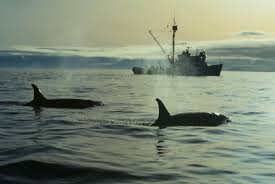
Boaters can help orcas by slowing down
A new study suggests speed can be a key factor.
BREMERTON, Wash. (AP) — A new University of Washington study of underwater noise finds that killer whales are bothered more by a fast boat than a large one or by a number of them in close proximity.
Studies have shown that the Puget Sound's Southern Resident orcas are affected by underwater noise produced by ships, ferries and smaller vessels. The whales spend more time and energy trying to communicate with each other over the noise, and they tend to hunt less, swim deeper and travel more when noise levels are high.
"Previous studies looked at how the number and distance of boats can affect the whales," said Juliana Houghton, a University of Washington aquatic sciences researcher and the lead author of the study. "This is the first that shows that speed is also important, and that if everybody decreased their speed, it would be helpful."
The study was conducted in conjunction with the National Oceanic and Atmospheric Administration, the Kitsap Sun reported.
It's the first study to examine how much noise from individual boats reaches the whales in the Salish Sea, which includes the sound and the waters between Vancouver Island and British Columbia mainland. A small motorized boat traveling at high speed can be more disruptive than a large, slow-moving vessel or a group of slow-moving boats.
NOAA considers vessel traffic one of the three main threats to the whales' recovery. The other threats are dwindling food sources and marine contamination.
Southern Resident whale populations have declined about 20 percent since 1990. This year, their numbers nudged just beyond 80, but the Southern Residents are falling short of the annual 1 percent growth rate specified under the state's killer whale recovery goals.
Researchers simultaneously used laser positioning systems to measure the distance between vessels and the whales and to gauge vessel speed and size.
The study did not assess the impact of large ships or ferries. The largest vessel studied was a 100-passenger whale-watching boat.
Federal rules require boats to stay at least 200 yards away from whales and at least 400 yards out of the path of whales. There's no speed limit, but NOAA recommends that boats slow to less than seven knots when within 400 yards of the nearest whale.
Speed has not been regulated because it's difficult to enforce and because speed had not — until now — been shown to be an important factor.
NOAA plans to review the effectiveness of vessel regulations next year.